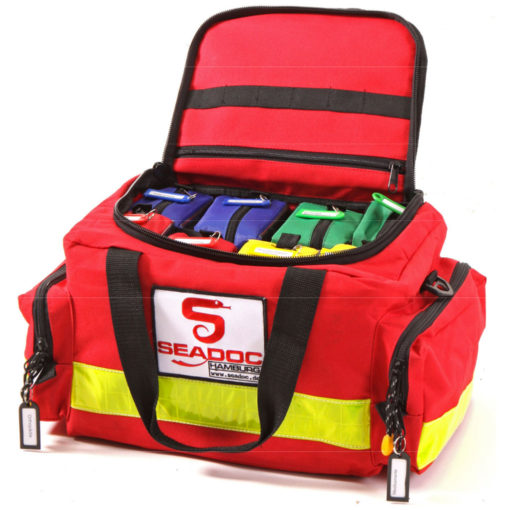Survival can be so wonderful
Preparing a sailing trip is usually fun. The most unfunny of the essential topics is without any doubt “Emergencies on board”, the medical department. Broken bones, burns, wounds, inflammations – there is plenty to do while sailing. It gets really stupid when you are days or weeks away from the next doctor or hospital. Then the crew has no choice but to promote the most medically competent person (f/m) to the ship’s doctor. We don’t have any physician on board (sorry Ka) and as amateurs we have to train and equip ourselves as far as possible so that we can arrive with a complete and healthy crew even without a doctor and approbation.
From my own experience I know how wonderful it can be when an injury is well treated and does not immediately lead to amputation.
The special thing about first aid on board is – unlike on land – that on long distances no doctor rings the bell even in a few hours. You are left on your own and the provisional first aid is not so provisional. So it is reassuring to have the right equipment and medication on board. A good training is also not harmful.
At our first Atlantic Crossing we had an amply equipped on-board pharmacy and rudimentary knowledge with us. Worked very well despite the challenges. At the next crossing the distances will be twice as long, so there will always be a lot of sea between the potential patient and professional help. More than enough water to invest time and money in our training and equipment.
So we conveniently met the Seadocs (seadoc.de) and attended an excellent seminar. During a very busy weekend we learned how to treat burns, fractures, bruises, inflammations, wounds, dehydration, shock – and also cool things like collapsed lungs or a stroke. We learned and practiced to give injections, infusions and sutures. You should have seen the joyful Ka sink a syringe into the arm of a volunteer. (he was fine afterwards)
I found the teaching of the likeable Dr. Fabian particularly instructive: “small things must remain small”. Normally I am more the Chuck Norris type and don’t care much about small things. But Fabian’s explanations were very convincing. Ignored, a cold can lead to more unpleasant and serious consequences, which are not usable on board. So it’s smart to treat them immediately.
Careful handling of cuts, burns and fractures – the most common emergencies on board – is also important to prevent more serious degeneration. Inflammations must be avoided at all costs. Hygiene, disinfection and the right treatment help to restore a damaged crew.
The Seadocs not only offer good training, but also perfect equipment for the most common medical emergencies, which can be treated by non-professionals. Everything is perfectly structured and accessible according to the type of emergency. Both for diagnosis and treatment. The boxes contain all the “tools” and aids needed in a specific case. In addition, there are detailed lists of recommended medications, which our wonderful future ex-doctor Theodora – we will miss her – described as “excellent” and gave us the prescription free. By the way, this is a recommendation for all sailors to at least have the on-board pharmacy checked by a family doctor. If you don’t have one and don’t want one, Seadoc.de can help you.
The procurement of the medicines was then entertaining. A typical pharmacist was very reluctant to hand over the prescription narcotics on our prescription. “They are only for anesthetists”, she said. Thats what I would prefer too but where in hell should we find an anesthetist in case of an emergency in the middle of the ocean, the lady could not answer us. Strange thoughts of strange people. I suppose the lady would rather die than be treated by amateurs. To each his own.
What’s more complicated in our case is transporting the drugs to our vessel. There are just plenty of prescription drugs in our box, which will be examined by the customs in South Africa. We will see how that works.
With our professional, lay-suitable equipment of the Seadocs, we feel well prepared on this trip for the hopefully missing medical emergencies / Holger Binz



Cooles Foto, Herr und Frau Doktor. An der Schweineschwarte herumexperimentiert? Hals- und Beinbruch oder wie sagt man wenn man auf hohe See geht?